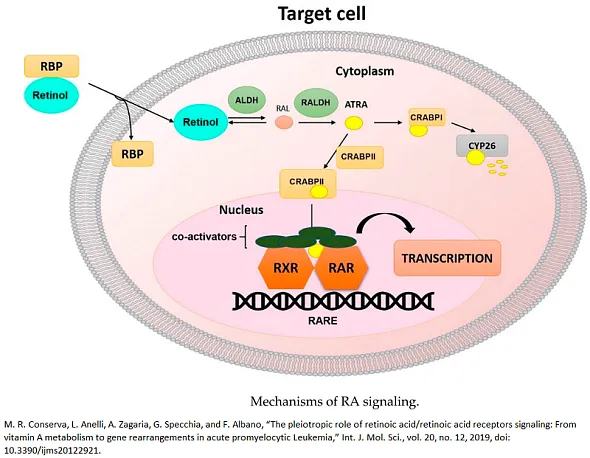RAR (Nuclear receptors) Ligands Library
ChemDiv’s library of small molecule compounds targeting retinoic acid nuclear receptors comprises 6,767 entries.
Nuclear receptors are a class of intracellular proteins that perceive and respond to steroid and thyroid hormones and a few other active molecules. Those receptors are linked to other proteins and regulate specific gene expression, thus controlling body development, homeostasis, and metabolism. Nuclear receptors possess the unique ability of binding directly to DNA and acting as transcription factors, regulating the expression of adjacent genes. This regulation typically occurs in the presence of a specific ligand, which is a molecule engaging with receptors. Ligand binding induces a conformational change in the receptor, activating it and leading to either upregulation or downregulation of gene expression. These receptors are crucial in both embryonic development and maintaining adult homeostasis.
The retinoic acid receptor (RAR) is a special type of nuclear receptor that functions as a transcription factor, activated by ligands such as all-trans retinoic acid and 9-cis retinoic acid. Agonist ligand binding to RAR leads to the dissociation of corepressor proteins and the recruitment of coactivator proteins, thereby promoting the transcription of downstream target genes into mRNA and subsequently into protein. Moreover, the expression of RAR genes is subject to epigenetic regulation, including promoter methylation.
RAR plays a pivotal role in drug discovery due to its central function in gene regulation and its involvement in a wide range of physiological processes and diseases. As a member of the nuclear receptor family, RAR is activated by retinoids, including all-trans retinoic acid and 9-cis retinoic acid, leading to the regulation of genes involved in cell differentiation, proliferation, and apoptosis. This makes RAR a critical target in the treatment of various skin disorders, cancers, particularly acute promyelocytic leukemia, where retinoids have been successfully used to induce differentiation and inhibit proliferation of cancer cells. Additionally, the role of RAR in embryonic development and its influence on cellular processes provide opportunities for the development of retinoids in managing developmental disorders and diseases associated with cell growth and differentiation. The modulation of RAR activity through synthetic ligands or inhibitors can thus offer therapeutic benefits in a variety of contexts, making it a versatile and valuable target in drug discovery.
Our small molecule library targeting retinoic acid receptors (RAR) offers significant benefits for drug discovery, providing a diverse range of compounds specifically designed to modulate RAR activity. This library is instrumental in identifying potential therapeutic agents for diseases where RAR plays a key role, such as certain types of cancer, skin disorders, and developmental diseases. The availability of these targeted molecules enables researchers to explore and develop both agonists and antagonists of RAR, allowing for a nuanced approach in regulating gene expression related to cell growth, differentiation, and apoptosis.
From the perspective of developing RAR inhibitors, this library presents opportunities to discover novel compounds that can effectively disrupt aberrant RAR signaling pathways in pathological conditions. In cancer therapy, particularly in types like acute promyelocytic leukemia where RAR is implicated, inhibitors could provide a strategy to counteract oncogenic processes. Additionally, in dermatological applications, RAR inhibitors might be used to manage conditions like acne or psoriasis. The library's focus on structural diversity and specificity also enhances the chances of identifying compounds with optimal pharmacological profiles, potentially leading to treatments with fewer side effects compared to existing therapies.
Our library targeting the retinoic acid receptor is a valuable resource in the drug development pipeline, offering prospects for creating innovative therapeutics in oncology, dermatology, and beyond.
